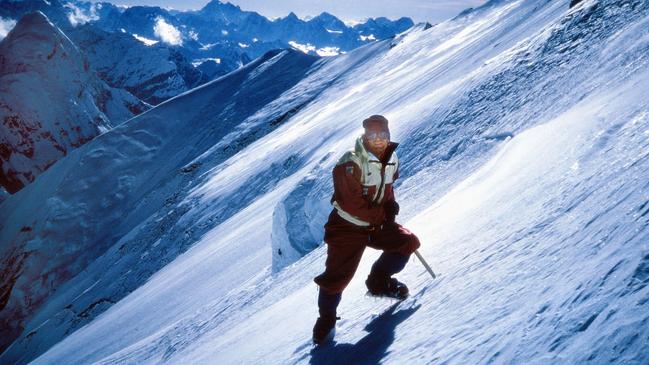Aussie’s Mt Everest warning as 5 dead, 3 missing, 200 frozen
Many have perished as they attempted to reach the top of Mt Everest — but it hasn’t stopped long queues of hikers paying thousands as Aussie experts warn of the dangers.

World
Don't miss out on the headlines from World. Followed categories will be added to My News.
When New Zealand mountaineer Sir Edmund Hillary made history by reaching the top of Mount Everest he famously declared: “We knocked the bastard off”.
Hillary, who conquered Everest with Sherpa Tenzing Norgay in May 1953, thought the world’s fascination with the mountain would end then.
“We thought that since we’d climbed it, people would lose interest,” he told one interviewer before his death in 2008.
Nothing could have been further from the truth.
Since then, thousands of people have climbed the 8849m peak even as the death toll from failed attempts grows.
A particularly tragic season doesn’t seem to deter adventurers, with a spike in climbers often seen the year after.

Last year, 18 people lost their lives on Mt Everest, including Australian Jason Kennison, 40, who died while he was on his way down after reaching the peak.
And here we are again – a season on – seeing new pictures of long lines of people in colourful ski jackets following each other closely inching their way towards the peak.
Greg Mortimer and his expedition partner Tim Macartney-Snape were the first two Australians to reach the summit of Mt Everest in 1984 – a feat they accomplished without the aid of supplementary oxygen.
Mr Mortimer can’t believe the hordes tackling it these days.
“There are too many people climbing it, yes. It’s simple. Look, those photos of queues are the most depressing photographs in mountaineering history,” Mr Mortimer said.
It was “inconceivable” in the 1980s, he said, to think of what Mt Everest tourism had now become; money driven (a trek to the top can cost between $30,000 and $100,000) and ruthless (some mountaineers have been snapped literally climbing over dead bodies to reach to the summit).

“It’s kind of mad at one level, because of the added danger that comes from it, and sad from the point of view such a beautiful life experience is being diminished by just too many people there at one time,” Mr Mortimer said.
He said anyone who climbed Mt Everest had achieved a great thing “whatever way – it’s wonderful.”
But with so many others being there, some of the wonder in the achievement of standing at the top of the world was lost.
“Those who climb in a queue won’t have the added depths of feeling that comes with being there by yourself or with few other people,” he said.
Standing at the top of Mt Everest showed him what a “delicate balance” it was to just be able to get to the highest peak on the planet. It was something he wouldn’t want to do with that many others jostling for the same position.
“I would run a mile from it … I wouldn’t go near a queue of people standing on a 8000m peak (because) of the importance of getting up and down as quickly as possible in order to be safe,” he said.
“The forces at work are so bloody powerful, as in nature … we were just like little bits of confetti in a big wind.”
Mr Mortimer said for every extra hour you are at “extremes of altitude (which) really amplifies your risk”.

Temperatures at the summit are well below freezing and during the peak season for climbing the average is around -26C.
“If you have to stand and wait you are exposing yourself exponentially to greater danger. Don’t be surprised if in the coming years we see that those queues get hit by a big storm and it’s multiple fatalities, which would be gut wrenching.”
“It’s can be really vicious. And there’s a constant state of alertness required to pay attention,’ he said.
However, the expeditions were far more equipped to gauge the weather now than they were in previous decades, he said.
Nepal’s Department of Tourism this year has issued Everest climbing permits to 419 fee-paying individuals, a slight decline from last year’s record 479 individuals granted permits.
Mr Mortimer said he “hated the thought” of putting caps on the number of people who could do things, but something needed to change.


“It’s wonderful there are more people to get exposed to the wonders of the Himalayas and the learnings from that come from extreme places (but) there’s been a change in the last 20 years in particular, it’s become a more gymnastic exercise. It’s like it’s an endurance feat, like a long distance run in extremis, which appeals to a different and greater number of people,” he said.
Five people have already died this season and three others are missing. They are among 300 people known to have died on Everest, and an estimated 200 of their bodies remain there because they were too hard to retrieve.
More than 500 climbers and their guides have this year reached the summit of Everest after a rope-fixing team reached the peak last month. Last year, more than 6000 made it to the top.
This year, China also reopened the Tibetan route to foreigners for the first time since closing it in 2020 because of the pandemic.
Nepal is home to eight of the world’s 10 highest peaks and welcomes adventurers during the northern hemisphere sprint from March to May, when temperatures are warmer and winds typically calm.





